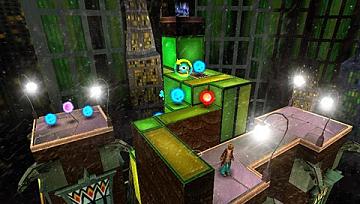Danny is an insomniac, and the more he tries to sleep, the more he can't. He decides the only thing left is to go through therapy, and he's plugged into the Cognitive Regression Utilizing Psychiatric Heuristics device, a helmet that lets him explore his own mind. Wouldn't that be "C.R.U.P.H.?" Danny asks the good doctor Reubens. Of course, that wouldn't have made as good of a name, would it?
 Crush is a title for patient souls out there: those of us who enjoy taking a step back and really looking at a level before making a move to try to solve it. A puzzle game at heart with light platforming elements, Crush takes us inside the mind of our hero as he tries to figure out why he can't sleep. The last thing I was expecting to find in a game like this was a decent story and a character I actually cared about, but the comic-book style cutscenes along with strong voice acting gave me a reason to keep going outside of the thrill I felt whenever I beat a level, and that rarely happens on the PSP.
Crush is a title for patient souls out there: those of us who enjoy taking a step back and really looking at a level before making a move to try to solve it. A puzzle game at heart with light platforming elements, Crush takes us inside the mind of our hero as he tries to figure out why he can't sleep. The last thing I was expecting to find in a game like this was a decent story and a character I actually cared about, but the comic-book style cutscenes along with strong voice acting gave me a reason to keep going outside of the thrill I felt whenever I beat a level, and that rarely happens on the PSP.
It turns out Danny's mind looks like a simplified version of Super Paper Mario: there are blocks and platforms and balls you can roll and bugs to avoid. Danny's brain is a pretty dangerous place, but luckily the machine has many failsafes—if you fall down you'll pop back up pretty close to where you were, and each level sports a checkpoint that lets you save your progress—so you can feel pretty free to explore. In each area you have to find a set amount of colored marbles (get it?) before the exit opens and allows you to leave. Most of the time getting to the exit doesn't involved a straight line, though: you'll have to "crush" the level to get ahead.
When you crush in the game, Danny stamps his foot down and turns the 3D world into 2D, allowing you to bring sections closer, eliminate elevation, or even bring walls together to smash the bugs that are invading his psyche. The game lets you move the camera freely, so your view as you crush determines where you can go. Crush while you're looking down at the top of Danny's head and you can walk from a tall section to a short one without falling, or if you're looking at Danny from the side you can step forward onto another section, and uncrush to find yourself across the board. It's a trippy concept and takes some trial and error to feel comfortable with it, but the mechanic is used to much better effect here than it was in Super Paper Mario; in Crush you have much more control over how the 3D-into-2D change occurs.
There are a few hidden items to find in each level—and each section of the game offers a handy tutorial to get you acclimated to the new moves and puzzles you'll be facing—but unless you like to really stretch your brain, this may be one to stay away from. I was ready to throw my PSP into the wall a few times even on the opening levels (a hint function is there when you feel like you just can't take it anymore).
You're also rated on how you perform on each puzzle and you can replay each as many times as you like to improve your score. These levels can take a long time to sort through; I was thankful that I could flip the system into sleep mode and walk away for a few minutes on many of them. The game does reward a deep level of concentration, and that's the sort of thing that makes the minutes and hours fly by when you're playing. Which is kind of the point of portable games.
Still, aside from the difficulty (or because of it) I felt a great sense of having really figured something out when I solved a puzzle that was giving me issues. This is a very deep and rewarding game, and if you can teach yourself how to take a deep breath and continue spinning the level and crushing to find the route to the exit, you're going to be impressed with one of the PSP's more original titles.
Verdict: Buy
System: PSP
Price: $30
Rating: E10
Developer: Zoe Mode
Publisher: SEGA
Other recent reviews:
reader comments